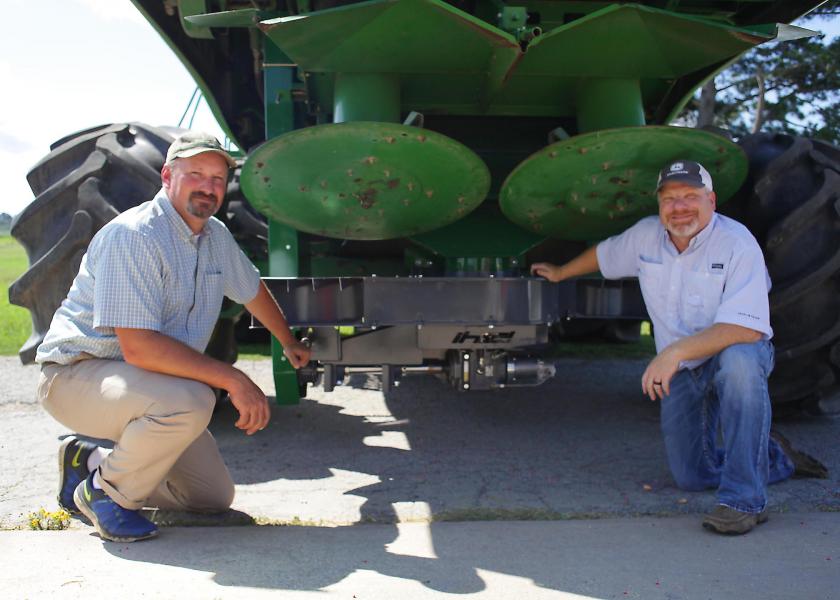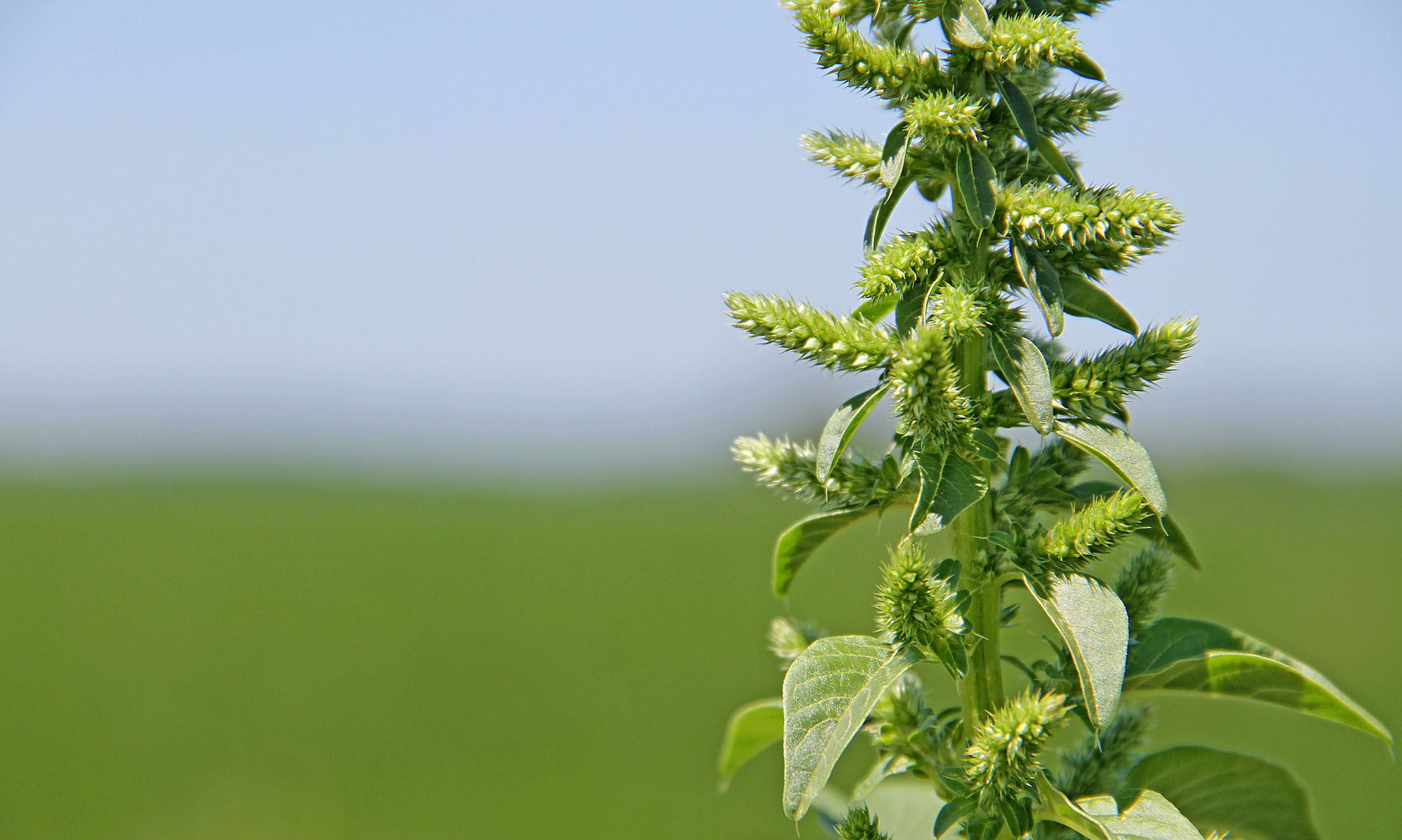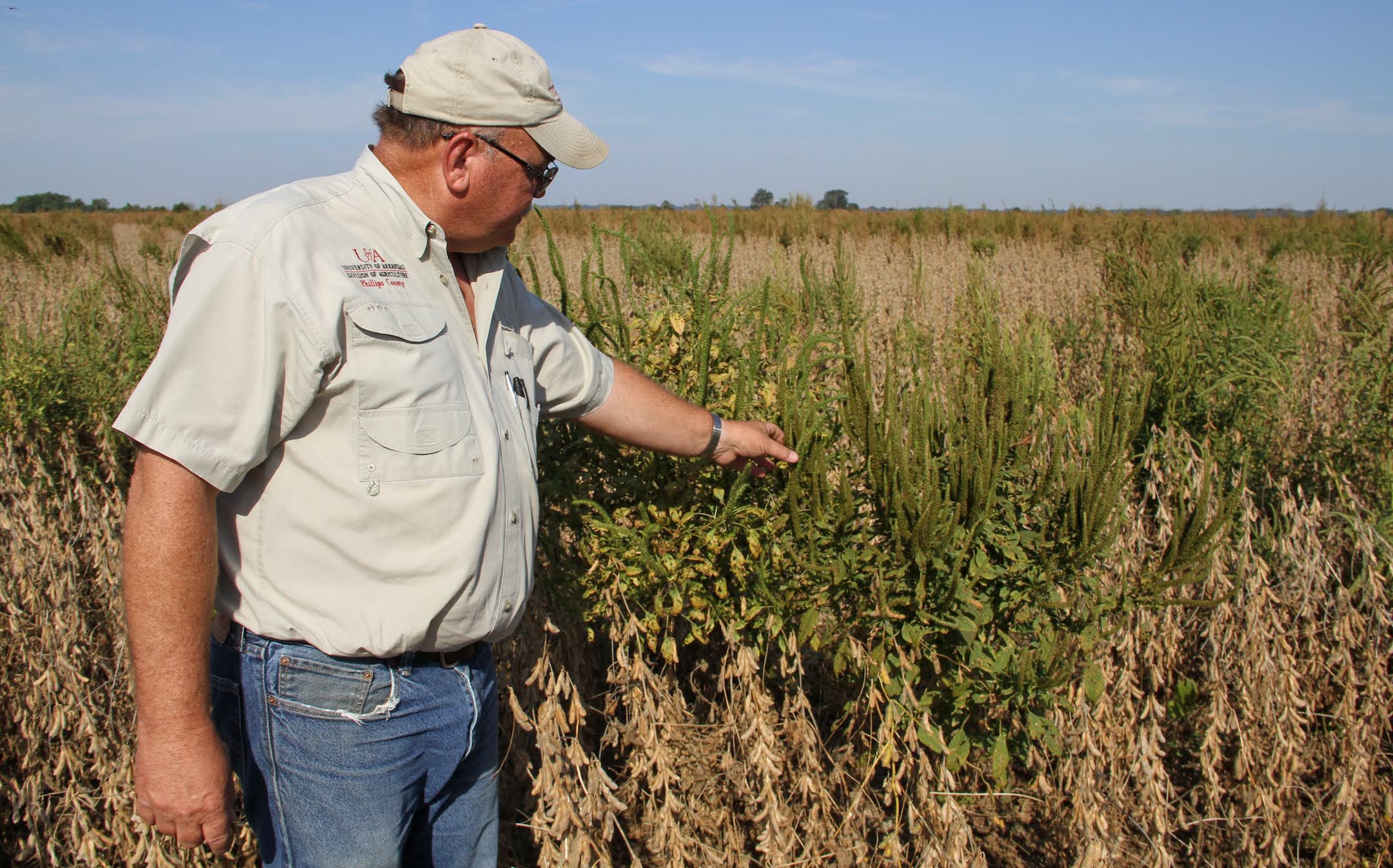Hammer Time: Combine Seed Mills Help Smash Herbicide Resistance

Smashing a weed seed to death as it passes through a combine is a technological reality fast approaching U.S. farmland. Seed mills, capable of chewing through vast amounts of weed seed at harvest, present farmers with a new means of weed control, and the bolt-on devices could play a significant role in the preservation of herbicide efficacy, i.e., steel protects chemicals.
Every year at harvest, farmers are forced to sign a devil’s deal. As crops are cut, combines suck in trillions of resistant weed seeds and provide the next generation of weeds with a free ride throughout fields. However, a deadly combo of seed mill steel and high velocity can hammer even the tiniest weed seeds—including Palmer amaranth and waterhemp—before they exit a combine.
Seed mill kill-rates show major promise for growers. “I feel confident we’ll have seed mill units running on combines in our fields within five years,” says Jason Norsworthy, a weed scientist with the University of Arkansas who has been at the blade’s edge of U.S. seed mill research since approximately 2010. “Just look at how desperate we are as herbicide efficacy continues to drop,” he adds. “Nothing works by itself, but seed mills can be a big tool in integrated weed control.”
Death by Impact
In 2009, as a succession of herbicide chemistries lost muscle on Arkansas farmland, particularly against Palmer amaranth—the scourge of Mid-South growers, Norsworthy caught wind of Harvest Weed Seed Control (HWSC), a multi-player, non-chemical system pioneered by Michael Walsh and a group of farmers in Australia, consisting of narrow-windrow burning, chaff carts, chaff lines, and seed mill tech.
At its simplest, HWSC is a preemptive attack to cut off the blood supply of the soil seed bank. Kill seeds at harvest; break the bank. Herbicide resistance is an overwhelming numbers game and the deck is stacked in favor of weeds with prodigious seed production, particularly species such as waterhemp in the Midwest and Palmer amaranth in the South. “Anytime we can lower the numbers of weed seed each fall that go back into the soil seed bank, that puts us that much further ahead in preventing resistance to the next herbicide,” Norsworthy explains.
Norsworthy has a front-seat to herbicide resistance, with a career spent in the crop rows of northeast Arkansas, where fields are often notoriously heavy with Palmer amaranth, a phenomenal weed beast that consistently slips the noose of chemical formulations sprayed its way. Known as pigweed, hogweed, devilweed, or a few more colorful monikers—Palmer amaranth is a seed bank bomb. An annual typically emerging in early spring and dying in late fall, Palmer amaranth plants can sometimes produce 500,000-plus seeds, all smaller than a pinhead. In several Southern states, Palmer amaranth germinates every month except January and February, and once above 4”, the weed can sometimes jump over 1” in a day.
As of 2021, Norsworthy has Palmer amaranth samples within his research greenhouse that were not effectively controlled by nine herbicide modes of action. “I suspect I’ve got a pigweed plant resistant to nine modes. Look at dicamba, 2,4-D, and glufosinate—we’ve already got pockets of pigweed resistant to them all.”
At the vanguard of HWSC testing and research on U.S. farmland, Norsworthy says seed mill technology, presently centered on three different seed mill companies—Harrington Seed Destructor, Seed Terminator, and Redekop—shows tremendous promise. “It’s all about impact, not pulverization,” he describes. “Imagine the damage to a human body if you throw a person against a wall at 500 miles per hour, and then think of the same thing done to a seed. The seed gets cracked and nicked, and it won’t germinate later in the soil. Death by high-velocity.”
Adios to Clogging?
In 2016, Norsworthy tested a stationary prototype bolt-on Harrington Seed Destructor connected to a PTO, and recorded high seed kill in all major weed species. “We ran it at about 3,000 rpm and put in pigweed, cocklebur, and other seeds, and we got 99% to 100% kill.”
In 2018 and 2019, Norsworthy trialed an Integrated Harrington Seed Destructor on a Class 7 combine in Arkansas soybeans and corn, working alongside UA weed scientist Tom Barber, another long-time veteran of the resistant weed wars. However, Norsworthy and Barber encountered frequent plugging of the Seed Destructor. Why? Female Palmer.
Male Palmer amaranth plants produce pollen and dry down, but females stay green until frost. In the Mid-South geography of Arkansas, Louisiana, and Mississippi, frost generally is absent until late November, yet most soybeans already have been cut. “We were cutting green pigweed and were frequently clogging the Harrington unit,” Norsworthy says. “The Harrington Seed Destructor may be ideal for a region like the Midwest, where you get an earlier freeze, but after a couple of years of trying, we needed to find another seed mill.”
Enter Redekop, a Canadian-manufactured seed mill. On a Class 9 combine, Norsworthy trialed a Redekop at the UA Experiment Station in Kaiser (Mississippi County), and Barber tested a unit at the UA Experiment Station in Newport (Woodruff County) at the tail-end of the 2020 harvest and for the full harvest of 2021.
The Redekop performance in soybeans is much improved over the integrated Harrington Seed Destructor, according to Norsworthy: “We have harvest corn and soybean research plots without clogging. When harvesting production soybeans with heavy infestations Palmer amaranth, we have had some clogging issues on the beater within the combine, but not within the mill. We are working with Redekop to change the air flow through the combine in hopes that this will eliminate this issue. We have chaff samples from harvested fields in the greenhouse and it appears that we are maintaining a high kill rate.”

In corn trials, once again, Norsworthy saw positive results. “We had zero issues or problems. The only corn question I’ve got before we analyze everything is how much seed we were actually getting in the combine.”
The pursuit of barnyardgrass in rice (high-moisture straw content) proved more difficult. “We had to desiccate rice with sodium chlorate. Once we did that, the performance of the Redekop unit functioned much better.”
“We’re still trying to figure out the best way for rice,” Norsworthy continues. “If we get the chaff into the seed mill, then there are no issues with clogging. Right now, we’re heading in the right direction, but I’m not going to come out and tell a grower, ‘Go buy a Redekop and you’ll be ready to cut.’ I’m not going to say that until I know more overall.”
Echoing Norsworthy, Iowa State University weed scientist Prashant Jha reports promising seed mill trial results focused on waterhemp. In 2020, he tested a Redekop on several hundred acres of soybeans in central Iowa: “Our results were very positive,” Jha says, “and we got over 90% seed kill efficacy on waterhemp. There were no issues of clogging with the combine, and the Redekop used about 40 horsepower.”
Jha recently wrote a USDA grant application for Redekop and chaff lining research in Arkansas, Kansas, and Iowa. With the grant approved by USDA, Jha is hopeful regarding seed mill adoption. “I can easily see where a seed mill could be used in the Midwest by larger growers with 5,000 to 10,000 acres, and smaller growers use a less expensive method such as chaff lining.”
No Solo Magic
No matter how effective, seed mill technology is a player in weed control, but not a cure-all, emphasizes Norsworthy. Some weeds shatter prior to harvest, such as barnyardgrass, which often sheds 50% of its seed before combines roll, giving seed mills a reduced shot at control.
By nature, weeds build resistance to any form of control—even non-chemical management, Norsworthy details. “Look at barnyardgrass in Asia. After hundreds of years of hand-weeding, there are barnyardgrass biotypes that look almost identical to rice, and that means they have developed resistance to hand-weeding. That is simple truth. Therefore, yes, the same thing could happen to seed mills, and that’s why a multifaceted approach is an absolute necessity.”

Palmer amaranth, he continues, is an absolute survival machine. “Pigweed can certainly develop resistance to a seed mill. For example, about 99% of pigweed is retained on the plant and may go into the combine. That means 1% of seeds shatter before the combine arrives. If you were to run a seed mill by itself for about 15 years—with no other weed control practice—you would select plants that shatter early. You can’t control pigweed with a magic new tactic, because nothing works alone.”
The Big Pic
When farmers catch wind of seed mill potential, most ask Norsworthy three immediate questions related to cost, efficacy, and combine compatibility.
“Guys are very interested, and we’ve got bugs to work out, and I believe they’ll be solved in less than five years.
Norsworthy projects seed mills will occupy a standard spot in the weed control toolbox due to two overarching factors: chemical loss and investment. “First, seed mills need to be integrated into our system because our herbicides face resistance issues in weeds,” he says. “Second, there is now harvest weed seed control research in at least 15 different states and that is going to produce an increased amount of seed mill data that growers need.”
“The better we understand seed mills and their role in weed management, the more we’ll strengthen the efficiency of our herbicides,” Norsworthy adds. “Weed control, no matter what method is used, is about the big picture.”
For questions or to read more stories from Chris Bennett (cbennett@farmjournal.com), see:
Skeleton In the Walls: Mysterious Arkansas Farmhouse Hides Civil War History
While America Slept, China Stole the Farm
Bizarre Mystery of Mummified Coon Dog Solved After 40 Years
Where's the Beef: Con Artist Turns Texas Cattle Industry Into $100M Playground
The Arrowhead whisperer: Stunning Indian Artifact Collection Found on Farmland
Fleecing the Farm: How a Fake Crop Fueled a Bizarre $25 Million Ag Scam
Truth, Lies, and Wild Pigs: Missouri Hunter Prosecuted on Presumption of Guilt?
US Farming Loses the King of Combines
Ghost in the House: A Forgotten American Farming Tragedy
Rat Hunting with the Dogs of War, Farming's Greatest Show on Legs
Misfit Tractors a Money Saver for Arkansas Farmer
Predator Tractor Unleashed on Farmland by Ag's True Maverick
Government Cameras Hidden on Private Property? Welcome to Open Fields
Farmland Detective Finds Youngest Civil War Soldier’s Grave?
Descent Into Hell: Farmer Escapes Corn Tomb Death
Evil Grain: The Wild Tale of History’s Biggest Crop Insurance Scam
Grizzly Hell: USDA Worker Survives Epic Bear Attack
A Skeptical Farmer's Monster Message on Profitability
Farmer Refuses to Roll, Rips Lid Off IRS Behavior
Killing Hogzilla: Hunting a Monster Wild Pig
Shattered Taboo: Death of a Farm and Resurrection of a Farmer
Frozen Dinosaur: Farmer Finds Huge Alligator Snapping Turtle Under Ice
Breaking Bad: Chasing the Wildest Con Artist in Farming History
In the Blood: Hunting Deer Antlers with a Legendary Shed Whisperer
Corn Maverick: Cracking the Mystery of 60-Inch Rows








